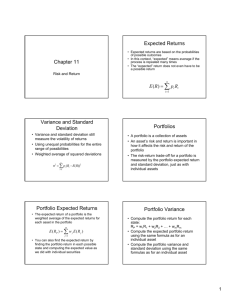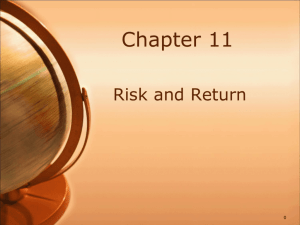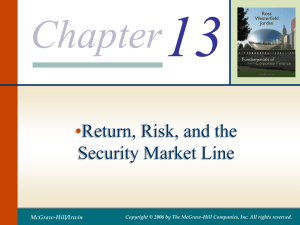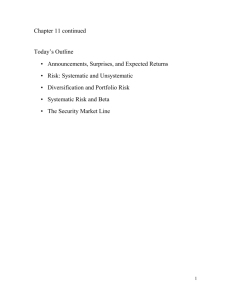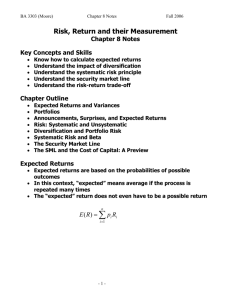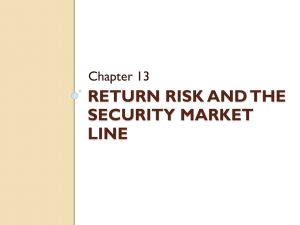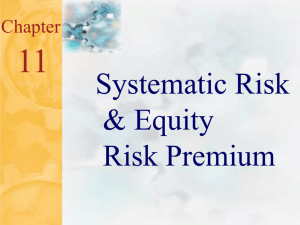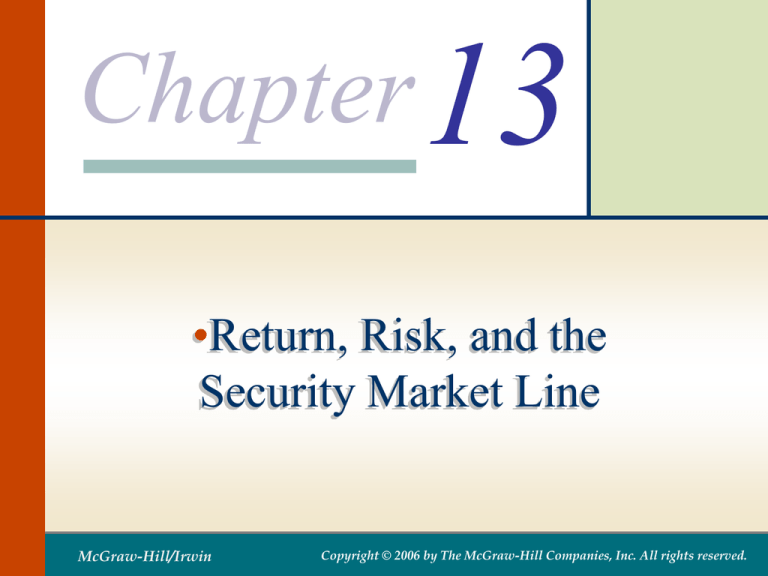
Chapter 13
•Return, Risk, and the
Security Market Line
McGraw-Hill/Irwin
Copyright © 2006 by The McGraw-Hill Companies, Inc. All rights reserved.
Expected Returns
• Expected Rate of Return
All possible outcomes and probabilities known
•
Kμ = E(R) = P1K1 + P2K2 + P3K3
Sample taken of past returns
•
_
•
K = ΣK/n
13-1
Example: Expected Returns
• Suppose you have predicted the following
returns for stocks C and T in three possible
states of nature. What are the expected
returns?
• State
Probability
C
• Boom
0.3
15
• Normal
0.5
10
• Recession ???
2
• RC = .3(15) + .5(10) + .2(2) = 9.99%
• RT = .3(25) + .5(20) + .2(1) = 17.7%
T
25
20
1
13-2
Sample of Observations
Returns:
2008 8.6%
2007 14.2%
2006 -4.6%
2005 8.8%
E(R) = Mean = (8.6+14.2-4.6+8.8)/4 = 6.75
13-3
Variance and Standard
Deviation
Variance: σ2 = P1(K1 - Kμ)2 + P2(K2 - Kμ)2 + P3(K3 - Kμ)2
_
_
_
Variance: S2 = [(K1 - K)2 + (K2 - K)2 + (K3 - K)2]/n-1
Standard Deviation = Square Root of Variance
13-4
Sample of Observations
Returns:
2008 8.6%
2007 14.2%
2006 -4.6%
2005 8.8%
E(R) = Mean = (8.6+14.2-4.6+8.8)/4 = 6/75
13-5
Example: Variance and
Standard Deviation
• Consider the previous example. What are the
variance and standard deviation for each stock?
• Stock C
• 2 = .3(15-9.9)2 + .5(10-9.9)2 + .2(2-9.9)2 = 20.29
• = 4.5
• Stock T
• 2 = .3(25-17.7)2 + .5(20-17.7)2 + .2(1-17.7)2 =
74.41
• = 8.63
13-6
Sample Variance
Variance
= [(8.6 – 6.75)^2 + (14.2 – 6.75)^2 + (-4.6 – 6.75)^2 + (8.8 – 6.75)^2] /3
= [3.4224 + 55,5025 + 128.8225 + 4.2025]/3 = 63.98333
Standard Deviation
= 63.98333^(1/2) = 7.998
Average Distance Around Mean
[(8.6 – 6.75) + (14.2 – 6.75) + (-4.6 – 6.75) + (8.8 – 6.75)] /4 = 5.675
13-7
Portfolios vs. Individual Stocks
• A portfolio is a collection of assets
• An asset’s risk and return are important in
how they affect the risk and return of the
portfolio
• The risk-return trade-off for a portfolio is
measured by the portfolio expected return
and standard deviation, just as with
individual assets
13-8
Individual Stocks’ Mean Return
θ
1
2
3
4
5
P
.2
.2
.2
.2
.2
K
W
-10
40
-5
35
15
40
-10
35
-5
15
Kμ = .2(-10) + .2(40) + .2(-5) + .2(35) + .2(15) = 15
Wμ = .2(40) + .2(-10) + .2(35) + .2(-5) + .2(15) = 15
13-9
Individual Stocks’ Variance
and Standard Deviation
θ
P
K
W
1
2
3
4
5
.2
.2
.2
.2
.2
-10
40
-5
35
15
40
-10
35
-5
15
(K-Kμ)2 (W-Wμ)2
625
625
400
400
0
625
625
400
400
0
σK = [.2(625) + .2(625) + .2(400) +.2(400) + .2(0)]½ = 20.25
σW = [.2(625) + .2(625) + .2(400) +.2(400) + .2(0)]½ =20.25
13-10
Equally Weighted
Portfolio Returns
θ
P
K
W
(K-Kμ)2
1
2
3
4
5
.2
.2
.2
.2
.2
-10
40
-5
35
15
40
-10
35
-5
15
625
625
400
400
0
(W-Wμ)2
625
625
400
400
0
.5K+.5W
15
15
15
15
15
Ex: (1) .5 x -10 + .5 x 40 = 15
Ex: (2) .5 x 40 + .5 x -10 = 15
13-11
Unequally Weighted
Portfolio Variance
θ
P
K
W
(K-Kμ)2
1
2
3
4
5
.2
.2
.2
.2
.2
-10
40
-5
35
15
40
-10
35
-5
15
625
625
400
400
0
(W-Kμ)2 .75K+.25W
625
625
400
400
0
2.5
27.5
5.0
25.0
15.0
Ex: (1) .75 x -10 + .25 x 40 = 2.5
Ex: (2) .75 x 40 + .25 x -10 = 27.5
13-12
Correlation of Security Returns
Perfect Positive = +1
Perfect Negative = -1
Uncorrelated = 0
13-13
Diversification
Total Risk =
Nondiversifiable Risk + Diversifiable Risk
Total Risk =
Systematic Risk + Unsystematic Risk
Total Risk =
Market Risk + Firm Risk
13-14
Systematic Risk
• Risk factors that affect a large number of
assets
• Also known as non-diversifiable risk or
market risk
• Includes such things as changes in GDP,
inflation, interest rates, etc.
13-15
Unsystematic Risk
• Risk factors that affect a limited number of
assets
• Also known as unique risk and assetspecific risk
• Includes such things as labor strikes, part
shortages, etc.
13-16
Diversification
• Portfolio diversification is the investment in
several different asset classes or sectors
• Diversification is not just holding a lot of
assets
• For example, if you own 50 internet stocks,
you are not diversified
• However, if you own 50 stocks that span
20 different industries, then you are
diversified
13-17
Table 13.7
13-18
The Principle of Diversification
• Diversification can substantially reduce the
variability of returns without an equivalent
reduction in expected returns
• This reduction in risk arises because worse
than expected returns from one asset are
offset by better than expected returns from
another
• However, there is a minimum level of risk
that cannot be diversified away and that is
the systematic portion
13-19
Figure 13.1
13-20
Diversifiable Risk
• The risk that can be eliminated by
combining assets into a portfolio
• Often considered the same as
unsystematic, unique or asset-specific risk
• If we hold only one asset, or assets in the
same industry, then we are exposing
ourselves to risk that we could diversify
away
13-21
Total Risk
• Total risk = systematic risk + unsystematic
risk
• The standard deviation of returns is a
measure of total risk
• For well-diversified portfolios, unsystematic
risk is very small
• Consequently, the total risk for a diversified
portfolio is essentially equivalent to the
systematic risk
13-22
Systematic Risk Principle
• There is a reward for bearing risk
• There is not a reward for bearing risk
unnecessarily
• The expected return on a risky asset
depends only on that asset’s systematic
risk since unsystematic risk can be
diversified away
13-23
Measuring Systematic Risk
• How do we measure systematic risk?
• We use the beta coefficient to measure
systematic risk
• What does beta tell us?
• A beta of 1 implies the asset has the same
systematic risk as the overall market
• A beta < 1 implies the asset has less
systematic risk than the overall market
• A beta > 1 implies the asset has more
systematic risk than the overall market
13-24
Total versus Systematic Risk
• Consider the following information:
• Security C
• Security K
Standard Deviation
20%
30%
Beta
1.25
0.95
• Which security has more total risk?
• Which security has more systematic risk?
• Which security should have the higher
expected return?
13-25
Examples of Betas
Edison Electricity
Coor’s Brewing
Sony
General Motors
Intel
Dell
.55
.75
.85
1.25
1.40
1.55
13-26
Example: Portfolio Betas
• Consider the following four securities
•
•
•
•
•
Security
DCLK
KO
INTC
KEI
Weight
.133
.2
.267
.4
Beta
2.685
0.195
2.161
2.434
• What is the portfolio beta?
• .133(2.685) + .2(.195) + .267(2.161) + .4(2.434)
= 1.9467
13-27
Beta and the Risk Premium
• Remember that the risk premium =
expected return – risk-free rate
• The higher the beta, the greater the risk
premium should be
• Can we define the relationship between
the risk premium and beta so that we can
estimate the expected return?
• YES!
13-28
Example: Portfolio Expected
Returns and Betas
30%
Expected Return
25%
E(RA)
20%
15%
10%
Rf
5%
0%
0
0.5
1
1.5A
2
2.5
3
Beta
13-29
Reward-to-Risk Ratio: Definition
and Example
• The reward-to-risk ratio is the slope of the
line illustrated in the previous example
• Slope = (E(RA) – Rf) / (A – 0)
• Reward-to-risk ratio for previous example =
(20 – 8) / (1.6 – 0) = 7.5
• What if an asset has a reward-to-risk ratio
of 8 (implying that the asset plots above
the line)?
• What if an asset has a reward-to-risk ratio
of 7 (implying that the asset plots below
the line)?
13-30
Market Equilibrium
• In equilibrium, all assets and portfolios
must have the same reward-to-risk ratio
and they all must equal the reward-to-risk
ratio for the market
E ( RA ) R f
A
E ( RM R f )
M
13-31
Security Market Line
• The security market line (SML) is the
representation of market equilibrium
• The slope of the SML is the reward-to-risk
ratio: (E(RM) – Rf) / M
• But since the beta for the market is
ALWAYS equal to one, the slope can be
rewritten
• Slope = E(RM) – Rf = market risk premium
13-32
The Capital Asset Pricing Model
(CAPM)
• The capital asset pricing model defines the
relationship between risk and return
• E(RA) = Rf + A(E(RM) – Rf)
• If we know an asset’s systematic risk, we
can use the CAPM to determine its
expected return
• This is true whether we are talking about
financial assets or physical assets
13-33
Factors Affecting Expected
Return
• Pure time value of money – measured by
the risk-free rate
• Reward for bearing systematic risk –
measured by the market risk premium
• Amount of systematic risk – measured by
beta
13-34
Example - CAPM
• Consider the betas for each of the assets given
earlier. If the risk-free rate is 2.13% and the
market risk premium is 8.6%, what is the
expected return for each?
Security
DCLK
KO
INTC
KEI
Beta
2.685
0.195
2.161
2.434
Expected Return
2.13 + 2.685(8.6) = 25.22%
2.13 + 0.195(8.6) = 3.81%
2.13 + 2.161(8.6) = 20.71%
2.13 + 2.434(8.6) = 23.06%
13-35
Figure 13.4
13-36
Chapter 12
•End of Chapter
McGraw-Hill/Irwin
Copyright © 2006 by The McGraw-Hill Companies, Inc. All rights reserved.


